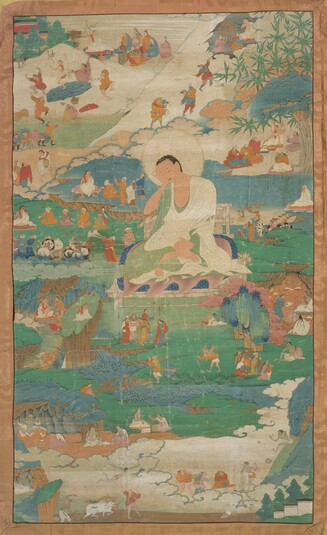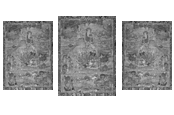
Item: Teacher (Lama) - Milarepa
| Origin Location | Tibet |
|---|---|
| Date Range | 1800 - 1899 |
| Lineages | Kagyu and Buddhist |
| Material | Ground Mineral Pigment on Cotton |
| Collection | Dr. David Nalin |
Milarepa: the great poet yogi of Tibet surrounded by life story vignettes. This painting belongs to a set of unknown number with only one other known painting definitely belonging to the same set: HAR 68329. There are also four other possible paintings similar in appearance that may very well belong to the same set. (See Milarepa Outline Page).
 mi la re pa
mi la re pa  Biographical Details
Biographical Details
The Nalin Collection composition depicts narratives from the middle part of Milarepa's life story. It contains scenes recalling the time that Milarepa's clay pot rolled down a hill and another incident where he was spotted by a farmer as he flew in the sky above and cast large shadows on the ground. Both of these narrative vignettes are found at the very bottom of the composition. Many of the vignettes in this painting can be found in painting number #9 of the famous nineteen painting Stockholm set.
The other painting from the set HAR 68329 is the last in the series and depicts the passing and cremation of Milarepa. In comparison with the Stockholm set HAR 68329 incorporates vignettes from paintings #16 through 19. Unfortunately this is still not helpful enough to determine exactly how many paintings belong to the full set, but it is likely that the number is far fewer than the nineteen painting set.
Jeff Watt 6-2009
-----------------------------------------------------------
The beloved Tibetan saint, Milarepa sits here in his classic pose, with his right hand cupped behind his ear, atop a bamboo throne within a landscape filled with scenes of his journey towards liberation. This painting is particularly remarkable in the refinement of its many small narrative scenes, depicting some of the most dramatic episodes of Milarepa’s journey towards liberation. Despite containing sixteen vignettes, the artist successfully represents each of them with the most minimal, yet meticulously detailed content, and leaves a sprawling landscape with ethereal space reminiscent of the New Karma Garri style of the 18th century, which was initiated by the artists Chokyi Jungne (the Eight Situpa known as Situ Panchen, b.1700-d.1744) and his late-life disciple Karsho Karma Tashi—both from Kham Province (Southeastern Tibet). Likewise, one can imagine that Situ’s monastery, Pelpung (Tib. dpal spung), would likely commission works like this given Milarepa’s prominent position in all Kagyu lineages.
The visual narrative flows in an inconsistent manner, depicting scenes as they best fit. The vignettes include his reputation as an amazing yogin spreading; his encounter with a deer fleeing hunters and his preaching of the dharma to an incredulous group thereafter; his sister Peta’s first encounter with him in many years, when she urges him to abandon his extreme practices out of concern for his nakedness and lack of nourishment; his flight back from Minkyuk to Drakar Taso, during which he is spotted by the brother of his uncle’s daughter-in-law; Peta’s return to the cave with his formerly-betrothed, Dzesé, bringing food and alcohol; his fall outside the entrance to his cave, his clay pot for nettle soup tumbling to the ground and breaking; his aunt’s visit to him, as she is filled with remorse for her maltreatment of his family and his sister’s attempt to thwart her visit by drawing back the bridge she needed to cross; Milarepa’s meeting with Zhiwa O and, later, with his female disciples in Choro Dritsam. Nearly all of these stories are told in Andrew Quintman’s translation of The Life of Milarepa by Tsangyong Heruka (b.1452-d.1507), published by Penguin in 2011. An image of this very thangka is printed on the cover of his widely-read translation.
Laura A. Weinstein, 2018/ Updated 4-2024
Front of Painting
English Translation of Inscription: Lord of the feast
Meeting the women of Choro
while flying back between Minkyuk and Drakar Taso, the brother of his uncle’s daughter-in-law seeing him and calling out his name
[his] sister visiting
his aunt coming to the cave
gods assembling for the knowledge of the master
becoming known as a savior while traveling
gratefully encircling the land of snow?
Wylie Transliteration of Inscription: tshogs kyi bdag po/
sbyong rong gi bu mo phun dang 'byal ba'i skor//
[brag dkar r]ta so dang smin 'khyug gnyis bar la 'phur byon pas sngar gui a khu'i sna [=mna’ ma] ma'i pha bu gnyis zhing smo ba dang 'byal [=mjal] ba//
sring mo dang 'byal ba'i skor/
a nis [r]ta sor……la du yongs la'i skor/
lha chen tshogs kyi bdag po di la rtags pa'i skor/
‘pho long kyabs du grags/
sa phyir gangs 'gur ?? skor/
Laura A. Weinstein, 2018
Collection: Christies New York (Painting. September, 2018)
Teacher: Milarepa Main Page
Teacher: Milarepa (Life Story Paintings & Sets)
Teacher: Milarepa Life Story (Chamdo Sets)
Collection of Dr. David Nalin
Teacher: Milarepa (Masterworks)
Collection of Zhiguan (Painting & Textile)

